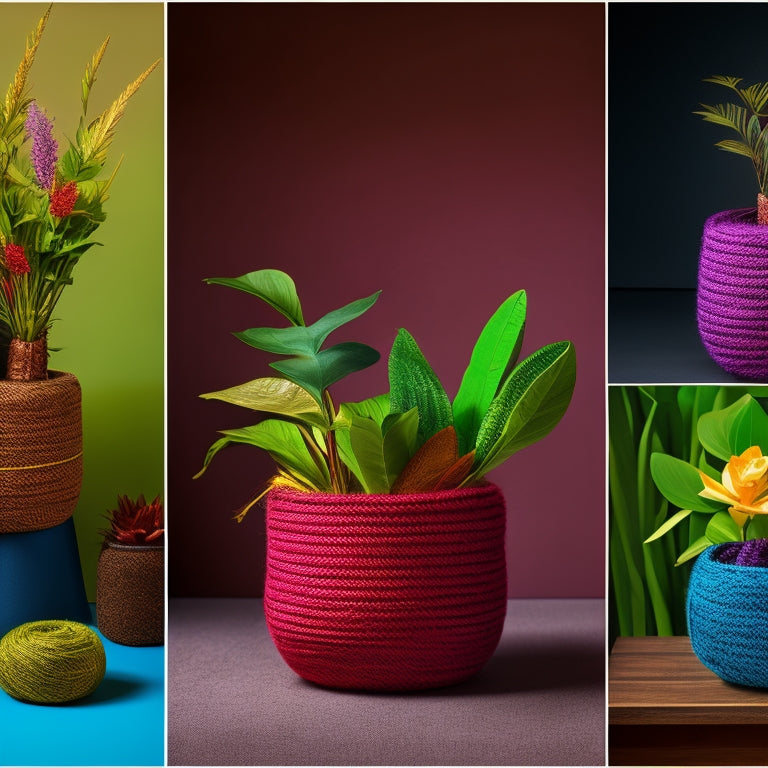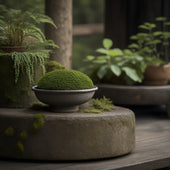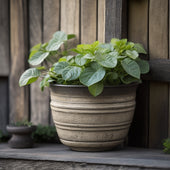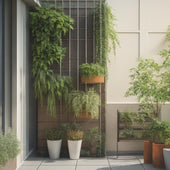
Why Insulate Planters With These 5 Best Materials
Share
You protect your plants from harsh temperatures and moisture fluctuations by insulating their planters with the right materials, as exposed roots and soil can be vulnerable to extreme conditions. Insulation helps regulate temperature, prevent moisture buildup, and create an ideal microclimate for plant health. The 5 best materials for this include recycled denim fibers, reflective bubble wrap, closed-cell foam board, natural wool, and straw or hay bales, each offering unique benefits such as sustainable practices, moisture retention, and pest deterrence. By choosing the right insulation, you can guarantee excellent growing conditions and take your plant care to the next level, exploring the specifics of each material to find the best fit for your plants.
Key Takeaways
• Insulating planters helps regulate temperature fluctuations, protecting plants from extreme heat or cold and promoting healthy growth.
• Insulation prevents moisture buildup, reducing the risk of root rot and other problems caused by excess water.
• By reducing heat transfer, insulation minimizes the need for frequent watering, conserving resources and benefiting moisture-loving plants.
• Insulating planters creates an ideal microclimate, supporting eco-friendly practices while reducing waste and promoting sustainable gardening.
• Effective insulation methods can reduce heat loss by up to 90%, enhancing the overall plant environment and contributing to successful harvests.
Insulating With Recycled Denim Fibers
By repurposing recycled denim fibers as a planter insulation material, you can create a sustainable, eco-friendly solution that not only reduces waste but also provides effective thermal protection for your plants.
This innovative approach to insulation leverages the natural thermal properties of denim to regulate temperature fluctuations, keeping your plants cozy in the winter and cool in the summer.
The fibers' unique structure allows for excellent air circulation, preventing moisture buildup and reducing the risk of root rot.
As you wrap the denim fibers around your planter, visualize the layers of protection working in harmony to maintain an ideal microclimate.
By choosing denim sustainability, you're not only reducing waste but also supporting eco-friendly practices.
With temperature regulation at its core, this insulation method guarantees your plants thrive in any environment.
Reflective Bubble Wrap Insulation
Wrap your planter in reflective bubble wrap insulation, a surprisingly effective solution that traps air pockets and reflects radiant heat, keeping your plants at the ideal temperature. This innovative material works by minimizing heat transfer, allowing your plants to thrive in prime conditions.
As you wrap the planter, the bubble wrap's reflective surface deflects radiant heat, ensuring that the soil temperature remains consistent. This thermal efficiency enables your plants to grow strong and healthy.
Moreover, the air pockets trapped within the bubble wrap provide excellent moisture retention, preventing water from escaping and keeping the soil consistently hydrated. This is especially beneficial for plants that require high levels of moisture, as it reduces the need for frequent watering.
Closed-Cell Foam Board Insulation
You can achieve superior insulation with closed-cell foam board insulation, which is specifically designed to minimize heat transfer and maximize thermal performance in planters.
This type of insulation is composed of tiny cells that are completely closed, making it an effective barrier against heat flow. As a result, it provides high thermal resistance, keeping your plants' roots cooler in the summer and warmer in the winter.
Furthermore, closed-cell foam board insulation is impervious to water, making it an excellent choice for planters that are exposed to moisture. Its moisture control properties prevent water from seeping into the insulation, which can compromise its performance.
When installed correctly, this insulation material can reduce heat loss by up to 90%, creating an ideal environment for your plants to thrive.
With its high R-value and durability, closed-cell foam board insulation is an excellent option for insulating planters. By using this material, you'll be able to create a consistent and ideal temperature for your plants, giving them the best chance to grow and flourish.
Natural Wool Insulation Method
Natural wool insulation, a sustainable and eco-friendly option, traps air pockets and slows down heat transfer, making it an effective method for regulating planter temperatures. As you consider using natural wool insulation, you'll appreciate its ability to maintain a consistent temperature, guaranteeing your plants thrive.
One of the natural wool benefits is its moisture-wicking properties, which prevent water from accumulating and causing root rot.
To apply wool insulation techniques, start by wrapping the planter with a layer of natural wool, making sure to cover all surfaces. You can use a mesh or burlap to hold the wool in place. Next, add a second layer of wool, overlapping the first layer to guarantee complete coverage. Finally, secure the wool with twine or wire, and your planter is insulated.
With natural wool insulation, you can enjoy a reduced risk of frost damage and improved plant health. By embracing this eco-friendly method, you'll not only protect your plants but also contribute to a more sustainable gardening practice.
Straw or Hay Bales Insulation
Straw or hay bales, a readily available and cost-effective material, can be repurposed as a planter insulation method that provides excellent thermal protection. You'll be surprised at how well they work! Not only do they provide great insulation, but they also offer several benefits that make them an attractive option.
Here are three benefits of using straw or hay bales as insulation:
-
Moisture regulation: Straw or hay bales can absorb excess moisture, reducing the risk of waterlogged soil and root rot.
-
Pest control: The dry, fibrous material can deter pests like slugs and snails that might otherwise target your plants.
-
Aesthetic appeal: Straw or hay bales can add a rustic, natural touch to your garden or outdoor space, blending seamlessly with your existing decor.
As a cost-effective solution, straw or hay bales offer a unique combination of thermal protection, moisture regulation, and aesthetic appeal.
Frequently Asked Questions
Can I Use Insulation Materials for Indoor and Outdoor Planters Interchangeably?
When choosing insulation materials, you'll want to take into account the unique demands of indoor and outdoor planters.
You can't simply use indoor insulation for outdoor planters, as it may not be durable enough to withstand harsh weather conditions.
Similarly, outdoor insulation might be too thick or heavy for indoor planters.
You need to select materials tailored to each environment to guarantee peak performance and plant health.
How Long Does Planter Insulation Typically Last Before Replacement?
As you tend to your planters, you're likely wondering how long your insulation will last before it needs a refresh.
The answer depends on the durability of the insulation material you've chosen. On average, high-quality insulation can last for 5-7 years before its performance starts to dwindle, signaling it's time for replacement.
However, exposure to harsh weather conditions or moisture can reduce its lifespan. Keep an eye out for signs of wear, and you'll know when it's time to swap it out for a new layer of protection.
Are There Any Insulation Materials Safe for Planters With Aquatic Plants?
When choosing insulation for planters with aquatic plants, you'll want to select safe materials that won't harm your underwater ecosystem.
Look for insulation materials that are non-toxic, waterproof, and resistant to mildew and algae growth.
Some safe options include foam boards, reflective insulation, and ceramic-based coatings.
Be sure to follow the manufacturer's instructions and take aquatic plant considerations into account to guarantee a thriving environment for your plants.
Can I Mix and Match Different Insulation Materials for Better Results?
Imagine wrapping your planter in a patchwork quilt of insulation materials - it's a tempting idea!
But, can you really mix and match for better results? The short answer is, it's complicated.
You'll need to take into account material compatibility to avoid a Frankenstein's monster of insulation.
Prioritize insulation effectiveness by selecting materials that work harmoniously together.
Research and test combinations to guarantee your aquatic plants thrive in their cozy, well-insulated home.
Do Insulated Planters Require More or Less Watering Than Non-Insulated Ones?
When you use insulated planters, you'll notice a significant impact on watering frequency.
Since insulated planters retain moisture better, you'll water them less often, as the soil stays hydrated for a longer period.
This means you'll reduce the frequency of watering, but make sure to check the soil's moisture levels regularly to avoid overwatering.
With insulated planters, you'll achieve a perfect balance of moisture retention and watering frequency, ensuring your plants thrive in their new habitat.
Conclusion
You've made it to the end of this insulation extravaganza!
By now, you're basically a planter-insulation mastermind, capable of shielding your plants from the harshest temperatures with the best materials out there.
With recycled denim fibers, reflective bubble wrap, closed-cell foam board, natural wool, and straw or hay bales, you'll be growing plants in the most extreme conditions like a boss!
Your plants will thrive in freezing winters and scorching summers, and you'll be the envy of every gardener on the block!
Related Posts
-

How Much Do Concrete Planters Weigh
When creating a concrete planter, you'll need to take into account the weight implications of your design. The type a...
-

How Much Do Concrete Planters Weigh
When creating a concrete planter, you'll need to take into account the weight implications of your design. The type a...
-

How Much Do Concrete Planters Weigh
When creating a concrete planter, you'll need to take into account the weight implications of your design. The type a...
-

How Much Do Concrete Planters Weigh
When creating a concrete planter, you'll need to take into account the weight implications of your design. The type a...
-

How Much Do Concrete Planters Weigh
When creating a concrete planter, you'll need to take into account the weight implications of your design. The type a...
-

How Much Do Concrete Planters Weigh
When creating a concrete planter, you'll need to take into account the weight implications of your design. The type a...
-

How Much Do Concrete Planters Weigh
When creating a concrete planter, you'll need to take into account the weight implications of your design. The type a...
-

How Much Do Concrete Planters Weigh
When creating a concrete planter, you'll need to take into account the weight implications of your design. The type a...
-

How Much Do Concrete Planters Weigh
When creating a concrete planter, you'll need to take into account the weight implications of your design. The type a...
-

How Much Do Concrete Planters Weigh
When creating a concrete planter, you'll need to take into account the weight implications of your design. The type a...
-

How Much Do Concrete Planters Weigh
When creating a concrete planter, you'll need to take into account the weight implications of your design. The type a...
-

How Much Do Concrete Planters Weigh
When creating a concrete planter, you'll need to take into account the weight implications of your design. The type a...
-

How Much Do Concrete Planters Weigh
When creating a concrete planter, you'll need to take into account the weight implications of your design. The type a...
-

How Much Do Concrete Planters Weigh
When creating a concrete planter, you'll need to take into account the weight implications of your design. The type a...
-

How Much Do Concrete Planters Weigh
When creating a concrete planter, you'll need to take into account the weight implications of your design. The type a...
-

How Much Do Concrete Planters Weigh
When creating a concrete planter, you'll need to take into account the weight implications of your design. The type a...
-

How Much Do Concrete Planters Weigh
When creating a concrete planter, you'll need to take into account the weight implications of your design. The type a...
-

How Much Do Concrete Planters Weigh
When creating a concrete planter, you'll need to take into account the weight implications of your design. The type a...
-

How Much Do Concrete Planters Weigh
When creating a concrete planter, you'll need to take into account the weight implications of your design. The type a...
-

How Much Do Concrete Planters Weigh
When creating a concrete planter, you'll need to take into account the weight implications of your design. The type a...
-

How Much Do Concrete Planters Weigh
When creating a concrete planter, you'll need to take into account the weight implications of your design. The type a...
-

How Much Do Concrete Planters Weigh
When creating a concrete planter, you'll need to take into account the weight implications of your design. The type a...
-

How Much Do Concrete Planters Weigh
When creating a concrete planter, you'll need to take into account the weight implications of your design. The type a...
-

How Much Do Concrete Planters Weigh
When creating a concrete planter, you'll need to take into account the weight implications of your design. The type a...
-

How Much Do Concrete Planters Weigh
When creating a concrete planter, you'll need to take into account the weight implications of your design. The type a...
-

How Much Do Concrete Planters Weigh
When creating a concrete planter, you'll need to take into account the weight implications of your design. The type a...
-

How Much Do Concrete Planters Weigh
When creating a concrete planter, you'll need to take into account the weight implications of your design. The type a...
-

How Much Do Concrete Planters Weigh
When creating a concrete planter, you'll need to take into account the weight implications of your design. The type a...
-

How Much Do Concrete Planters Weigh
When creating a concrete planter, you'll need to take into account the weight implications of your design. The type a...
-

What Makes a Beautiful Border Planter Design
When crafting a beautiful border planter design, you balance fundamental elements like durable cinder block structure...
-

What Makes a Beautiful Border Planter Design
When crafting a beautiful border planter design, you balance fundamental elements like durable cinder block structure...
-

What Makes a Beautiful Border Planter Design
When crafting a beautiful border planter design, you balance fundamental elements like durable cinder block structure...
-

What Makes a Beautiful Border Planter Design
When crafting a beautiful border planter design, you balance fundamental elements like durable cinder block structure...
-

What Makes a Beautiful Border Planter Design
When crafting a beautiful border planter design, you balance fundamental elements like durable cinder block structure...
-

What Makes a Beautiful Border Planter Design
When crafting a beautiful border planter design, you balance fundamental elements like durable cinder block structure...
-

What Makes a Beautiful Border Planter Design
When crafting a beautiful border planter design, you balance fundamental elements like durable cinder block structure...
-

What Makes a Beautiful Border Planter Design
When crafting a beautiful border planter design, you balance fundamental elements like durable cinder block structure...
-

What Makes a Beautiful Border Planter Design
When crafting a beautiful border planter design, you balance fundamental elements like durable cinder block structure...
-

What Makes a Beautiful Border Planter Design
When crafting a beautiful border planter design, you balance fundamental elements like durable cinder block structure...
-

What Makes a Beautiful Border Planter Design
When crafting a beautiful border planter design, you balance fundamental elements like durable cinder block structure...
-

What Makes a Beautiful Border Planter Design
When crafting a beautiful border planter design, you balance fundamental elements like durable cinder block structure...
-

What Makes a Beautiful Border Planter Design
When crafting a beautiful border planter design, you balance fundamental elements like durable cinder block structure...
-

What Makes a Beautiful Border Planter Design
When crafting a beautiful border planter design, you balance fundamental elements like durable cinder block structure...
-

What Makes a Beautiful Border Planter Design
When crafting a beautiful border planter design, you balance fundamental elements like durable cinder block structure...
-

What Makes a Beautiful Border Planter Design
When crafting a beautiful border planter design, you balance fundamental elements like durable cinder block structure...
-

What Makes a Beautiful Border Planter Design
When crafting a beautiful border planter design, you balance fundamental elements like durable cinder block structure...
-

What Makes a Beautiful Border Planter Design
When crafting a beautiful border planter design, you balance fundamental elements like durable cinder block structure...
-

What Makes a Beautiful Border Planter Design
When crafting a beautiful border planter design, you balance fundamental elements like durable cinder block structure...
-

What Makes a Beautiful Border Planter Design
When crafting a beautiful border planter design, you balance fundamental elements like durable cinder block structure...
-

What Makes a Beautiful Border Planter Design
When crafting a beautiful border planter design, you balance fundamental elements like durable cinder block structure...
-

What Makes a Beautiful Border Planter Design
When crafting a beautiful border planter design, you balance fundamental elements like durable cinder block structure...
-

What Makes a Beautiful Border Planter Design
When crafting a beautiful border planter design, you balance fundamental elements like durable cinder block structure...
-

What Makes a Beautiful Border Planter Design
When crafting a beautiful border planter design, you balance fundamental elements like durable cinder block structure...
-

What Makes a Beautiful Border Planter Design
When crafting a beautiful border planter design, you balance fundamental elements like durable cinder block structure...
-

What Makes a Beautiful Border Planter Design
When crafting a beautiful border planter design, you balance fundamental elements like durable cinder block structure...
-

What Makes a Beautiful Border Planter Design
When crafting a beautiful border planter design, you balance fundamental elements like durable cinder block structure...
-

What Makes a Beautiful Border Planter Design
When crafting a beautiful border planter design, you balance fundamental elements like durable cinder block structure...
-

What Makes a Beautiful Border Planter Design
When crafting a beautiful border planter design, you balance fundamental elements like durable cinder block structure...
-

What Makes a Beautiful Border Planter Design
When crafting a beautiful border planter design, you balance fundamental elements like durable cinder block structure...
-

What Makes a Beautiful Border Planter Design
When crafting a beautiful border planter design, you balance fundamental elements like durable cinder block structure...
-

3 Best Space-Saving Gardening Ideas for Urban Renters
You can turn even the smallest urban space into a lush oasis by utilizing clever space-saving gardening ideas. Maximi...
-

3 Best Space-Saving Gardening Ideas for Urban Renters
You can turn even the smallest urban space into a lush oasis by utilizing clever space-saving gardening ideas. Maximi...
-

3 Best Space-Saving Gardening Ideas for Urban Renters
You can turn even the smallest urban space into a lush oasis by utilizing clever space-saving gardening ideas. Maximi...
-

3 Best Space-Saving Gardening Ideas for Urban Renters
You can turn even the smallest urban space into a lush oasis by utilizing clever space-saving gardening ideas. Maximi...
-

3 Best Space-Saving Gardening Ideas for Urban Renters
You can turn even the smallest urban space into a lush oasis by utilizing clever space-saving gardening ideas. Maximi...
-

3 Best Space-Saving Gardening Ideas for Urban Renters
You can turn even the smallest urban space into a lush oasis by utilizing clever space-saving gardening ideas. Maximi...
-

3 Best Space-Saving Gardening Ideas for Urban Renters
You can turn even the smallest urban space into a lush oasis by utilizing clever space-saving gardening ideas. Maximi...
-

3 Best Space-Saving Gardening Ideas for Urban Renters
You can turn even the smallest urban space into a lush oasis by utilizing clever space-saving gardening ideas. Maximi...
-

3 Best Space-Saving Gardening Ideas for Urban Renters
You can turn even the smallest urban space into a lush oasis by utilizing clever space-saving gardening ideas. Maximi...
-

3 Best Space-Saving Gardening Ideas for Urban Renters
You can turn even the smallest urban space into a lush oasis by utilizing clever space-saving gardening ideas. Maximi...
-

3 Best Space-Saving Gardening Ideas for Urban Renters
You can turn even the smallest urban space into a lush oasis by utilizing clever space-saving gardening ideas. Maximi...
-

3 Best Space-Saving Gardening Ideas for Urban Renters
You can turn even the smallest urban space into a lush oasis by utilizing clever space-saving gardening ideas. Maximi...
-

3 Best Space-Saving Gardening Ideas for Urban Renters
You can turn even the smallest urban space into a lush oasis by utilizing clever space-saving gardening ideas. Maximi...
-

3 Best Space-Saving Gardening Ideas for Urban Renters
You can turn even the smallest urban space into a lush oasis by utilizing clever space-saving gardening ideas. Maximi...


